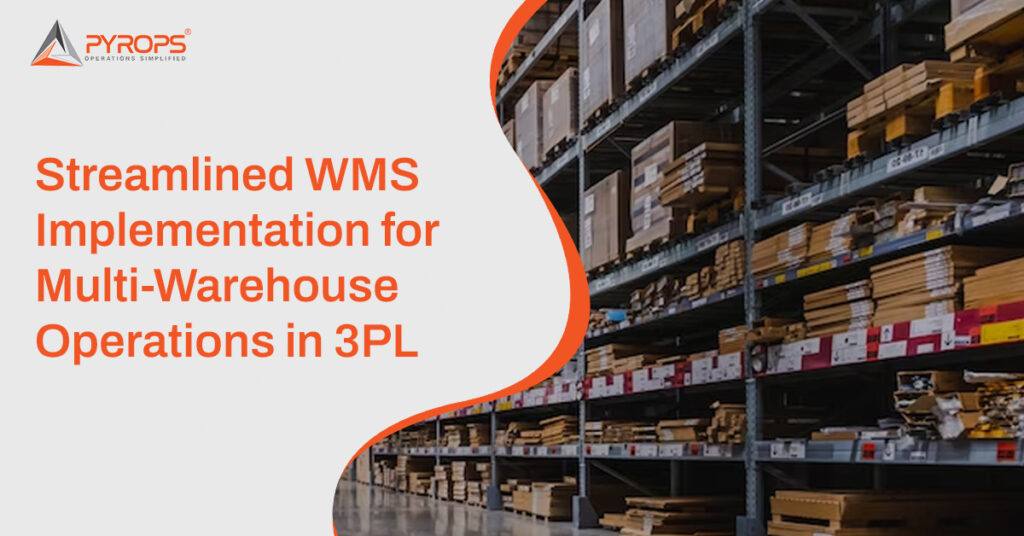Effective warehouse management is vital for the success of 3PL and e-commerce businesses. To meet growing customer demands and navigate the complexities of managing multiple warehouses, implementing a robust Warehouse Management System (WMS) is crucial. A centralized WMS across various warehouse locations can optimize operations, enhance inventory accuracy, streamline order fulfillment, and deliver overall efficiency gains. However, implementing a WMS in a multi-warehouse environment requires careful planning and execution.
In this blog, we explore challenges faced by warehouse managers, highlight the benefits of a powerful WMS, discuss key features for selection, and provide insights and strategies for successful implementation. Whether you’re a 3PL provider or a business with a vast network of warehouses, this blog offers the knowledge needed to streamline operations and achieve remarkable efficiency through WMS implementation.
Need of WMS System in 3PL Warehouse Management
Running a 3PL operation without a reliable Warehouse Management System (WMS) is akin to sailing an ocean without a compass—an extremely challenging endeavor. WMS is indispensable for 3PL operations, providing order to the complexity of handling diverse inventory for multiple clients. It improves inventory accuracy, minimizes order fulfillment errors, and accelerates delivery times—critical factors for sustaining client satisfaction and staying competitive in the logistics industry.
What is a 3PL Warehouse Management system?
A 3PL Warehouse Management System (WMS) is a software solution designed to efficiently manage and optimize the operations of third-party logistics providers (3PLs) responsible for handling and storing inventory on behalf of multiple clients. 3PL WMS system streamlines various warehouse processes, including inventory tracking, order fulfillment, and shipment management. By providing real-time visibility into inventory levels, improving accuracy, and enhancing overall operational efficiency, a 3PL WMS software contributes to effective logistics management and client satisfaction.
Challenges faced in Multi warehouses

Juggling multiple warehouse operations presents a slew of challenges that businesses must face head-on. These challenges cover a wide range of critical areas, each of which necessitates careful attention and strategic solutions. Let’s look at the main challenges that come with running multiple warehouses:
Inventory Visibility: Lack of real-time visibility into inventory levels across all warehouses can lead to stockouts, overselling, and poor customer satisfaction.
Order Fulfillment Efficiency: Coordinating order fulfillment across multiple warehouses can be complicated, resulting in delays, errors, and increased costs.
Scalability: As the number of warehouses and inventory volumes grows, managing operations manually becomes increasingly challenging, leading to inefficiencies and operational bottlenecks.
Data Integration: Consolidating data from multiple warehouses and ensuring accurate and up-to-date information can be time-consuming and prone to errors.
Resource Utilization: Optimizing resource utilization across multiple warehouses is complex, across labor, equipment, and space. Inefficient resource allocation can lead to underutilization or overutilization, impacting operational costs and productivity.
Vendor and Client Collaboration: Coordinating with vendors and clients across multiple warehouses requires effective communication and collaboration. Ensuring timely and accurate information exchange, managing vendor relationships, and meeting client-specific requirements can be challenging without streamlined processes and tools.
How 3PL WMS software Helps solve these challenges
Unlocking the potential of an efficient Warehouse Management System (WMS) can be a game changer for businesses with multiple warehouses. This powerful software solution is designed specifically to streamline and optimize various aspects of warehouse operations. Organizations can effectively address the aforementioned challenges and achieve significant improvements in:
Centralizing Inventory: An Enterprise WMS provides real-time centralized visibility into inventory levels across all warehouses, enabling businesses to make data-driven decisions, avoid stockouts, and optimize stock allocation.
Order Consolidation and Routing: A WMS streamlines order fulfillment by consolidating orders from various warehouses and determining the most efficient routing, minimizing shipping costs and delivery times.
Scalability and Flexibility: WMS systems are scalable and can accommodate the growth of a multi-warehouse network. They can handle increased inventory volumes and adapt to changing business requirements.
Data Integration and Accuracy: A WMS integrates with various systems, such as Enterprise Resource Planning (ERP) and Transportation Management Systems (TMS), ensuring accurate and synchronized data across all warehouses.
Key Features of WMS for 3PL warehouse system
A robust 3PL Warehouse management software should include essential features to ensure seamless operations and efficient inventory management. These features have been meticulously designed to provide businesses with the tools they require to thrive in the ever-changing world of warehousing. The following are key features of a high-quality WMS software:
Multiple Units of Measure: The software should be able to handle products measured in different units, such as weight, volume, or quantity. It should be able to seamlessly convert between other units, allowing for accurate inventory tracking and order fulfillment.
Vendor Management: In a multi-vendor warehouse, effective vendor management capabilities are critical. The software should allow for streamlined vendor onboarding, as well as easy communication, performance tracking, and collaboration. This feature improves vendor relations and ensures smooth coordination.
Inventory Tracking and Management: In a multi-vendor warehouse environment, accurate and real-time inventory tracking is critical. The software should include comprehensive inventory management features that allow for accurate tracking, monitoring, and control of stock levels in various units of measurement. It should support automated replenishment and provide real-time inventory movement updates across vendors.
Order Fulfillment: The software should have strong order fulfillment capabilities tailored to multi-vendor operations. It should make order management, picking, packing, and shipping processes easier by considering multiple measurement units. This feature allows for the efficient consolidation of orders, the optimization of picking routes, and the generation of accurate shipping labels and documentation.
Integration Capabilities: Seamless integration with other systems is crucial in a multi-client warehouse. The software should have the ability to integrate with e-commerce platforms, ERP systems, transportation management systems, and other relevant software. This integration ensures the smooth flow of data and eliminates manual data entry or reconciliation efforts, especially when dealing with different units of measure.
Reporting and Analytics: Comprehensive reporting and analytics features are vital for monitoring enterprise resource planning and making data-driven decisions. The software should provide customizable reports, dashboards, and analytics tools that offer insights into key metrics related to inventory turnover, order accuracy, vendor performance, and fulfillment cycle times, considering the multiple units of measure.
Scalability and Flexibility: As the warehouse expands and adapts to changing business needs, the software should be scalable and flexible. It should accommodate the addition of new vendors, products, and warehouse locations, while still maintaining performance and supporting different units of measure. Customization and configuration options are also beneficial to align the software with specific workflow requirements.
WMS Implementations strategy
Starting the implementation process for a Warehouse Management System (WMS) can be a daunting task that necessitates meticulous planning and execution. To ensure a successful and smooth transition, it is critical to develop a comprehensive implementation strategy that includes a series of well-defined steps. Businesses can avoid the complexities of WMS implementation by following these steps. Here are the key steps to include in a solid implementation strategy:
Planning: The first step is to plan the implementation. This includes defining the scope of the project, identifying the stakeholders, and developing a timeline and budget.
System selection: The next step is to select the right WMS. This involves evaluating different WMSs and selecting the one that best meets your needs.
System configuration: Once the WMS has been selected, it needs to be configured to meet your specific requirements. This includes setting up the system for your products, warehouses, and processes.
Training: The next step is to train your staff on how to use the WMS. This includes training on the system’s features and functionality, as well as on the processes that need to be changed as a result of the implementation.
Go-live: The final step is to go live with the WMS. This involves testing the system and making any necessary adjustments before production.
Pyrops WMS System Implementations strategy
Streamlining warehouse operations within a 3PL network with multiple locations can be a daunting task. Nonetheless, businesses can overcome these obstacles by leveraging the power of a strong Warehouse Management System (WMS).
A comprehensive WMS solution can help to centralize inventory management, improve order fulfillment processes, and improve scalability and data integration.
Businesses can reap numerous benefits from carefully selecting the best WMS and implementing a well-defined implementation strategy, including increased operational efficiency, increased customer satisfaction, and increased profitability in their multi-warehouse operations.






